SearchingforPeace
Well-known member
- Joined
- Jun 9, 2015
- Messages
- 5,714
- MBTI Type
- ENFJ
- Enneagram
- 9w8
- Instinctual Variant
- sx/so
Intro (skip if you just want the meat)
I was in the middle of a discussion regarding the use of Fe and Fi in a private blog and something that had been on my mind for awhile struck me and I spent some time trying to flesh out some ideas that been having regarding JCF and MBTI and what we think we know about the functions.
Now I know reckful has been defending the MBTI (in posts like these and clarifying with lots of details and questioning the functions in posts like the ones found in this thread. From reading his stuff, there is a lot of evidence supporting the entire concept of the MBTI, and strong correlations between MBTI and the way people act.
And that there is a lot less evidence for the Jungian Cognitive Functions model, but that seems to be the area where most people here and other personality sites seem to be focused on, with regular debates about Fi and Fe and Te and such.
Now, I watched this video a few months ago:
and I found it very interesting. I still haven't got around to reading Nardi's book, but I found what he presented to seem to bridge the great divide between science and the field of personality typing.
Anyway, yesterday, after reading a discussion of what Fi does around other people that it focuses on, I recognized what seemed to be an identical process that I do myself, and I am definitely a NFJ, not a Fi-user.
Meat
Here are the Nardi composite brain scans for typical ESTJs, ENFJs, INFPs, ESTPs, and ENFPs, highlighting the most used areas he observed in use, followed by the second most used areas.
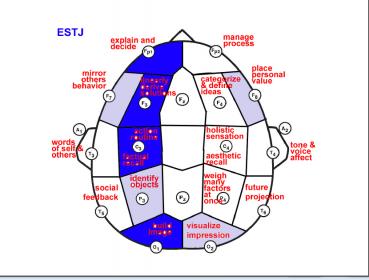
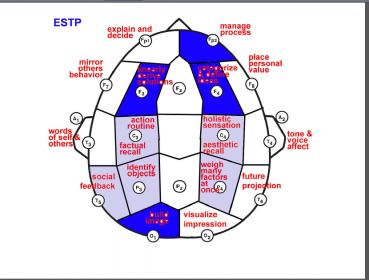
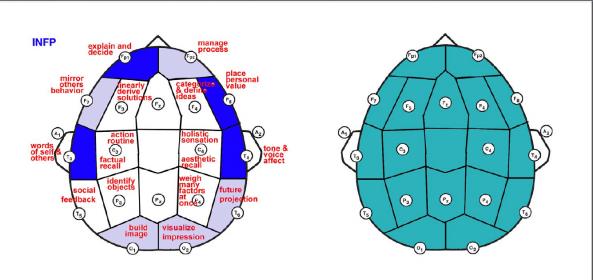
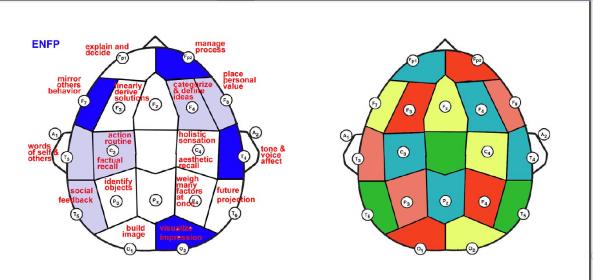
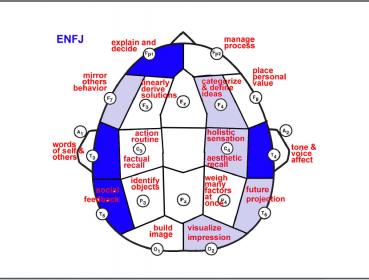
Nardi stated in his talk that a very high percentage of those that tested as a certain personality typed had near identical brain activity patterns.
As I looked these images, a few things struck me very quickly, but then I took the data to a spreadsheet and things really started to pop.
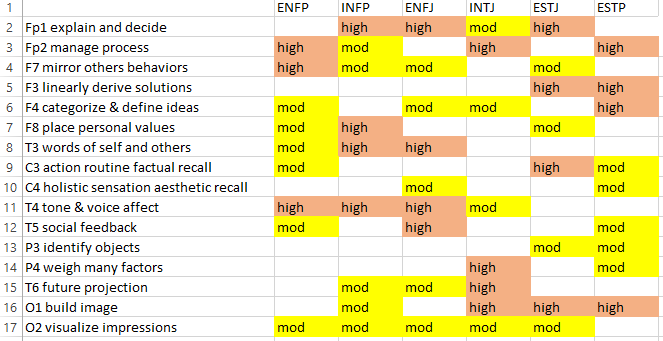
Fp1 (left side front lobe) is strongly associated with judgers, while Fp2 is associated with perceivers. Except for the INTJ and INFP, who do everything differently (and use both). I had thought that ENFP and INFP might have similar functions, but they really are not that close.
ENFPs have high use of Fp2, F7, T4, and moderate use of F4, F8, C3, T5, and O2.
INFPs have high of Fp1, F8, T3, and T4 and moderate use of Fp2, F7, T6, O1, and O2.
ENFJs share every high use area with INFPs except for regarding values, while the only area that ENFPs and INFPs use to high effect is T4 (tone and effect), which is an area that ENFJs also use to high effect.
ENFPs, interesting enough, use both value areas, F8 which INFPs use, which has been associated with Fi, and T5, which ENFJs use, which is associated with Fe, but to moderate use only.
INTJs show their tertiary Fi with moderate use of F8, while ESTPs show their tertiary Fe with moderate use of T5. ESTjs show their inferior Fi with moderate use of F8.
I do need to get the book to expand the spreadsheet to all 16 types, but I feel there is some basis to the idea of cognitive functions, but perhaps that our current definitions may lack clarity.
I remember reading in Gifts Differing that each type shares similarities at various levels. A INFP would share traits with a I, N, F, P, IN, IF, IP, NF, NP, FP, INF, NFP, IFP, and INP. The functions model would seem to precluded that, as a INFJ and INFP share zero functions, but may indeed share many similar characteristics.
The two ESTs seem to have more similarities than the JCF model would suggest, given that they share no functions. Both use F3 (linearly derive solutions) and O1 (build image) as high use areas, but they use opposite sides of the frontal lobe for judging (J vs. P issue). C3 seems Si related (action routine factual recall) and is used to high amount by the ESTJs, but is also used moderately by ESTPs.
From a personal standpoint, I know that I and my INFJ sister share many similar qualities and act in many ways the same. The main differences are that she is much more reserved and I am much more animated and active. Both of us were that way from early childhood. I have been told by others as well that ENFJs and INFJs seem very similar in many ways and seem to think extremely alike.
I do notice some strong similarities between myself and my ENFP sister, but also substantial differences, making it a close, but not as close situation.
Things like Fi and Fe may be much closer than we assume and the differences focus primarily on the F8 vs. T5 point, with much of the other use of these functions extremely similar. Likewise, the ESTJ and ESTP have some strong similarities in their usage areas, so the primary difference seems to J vs. P rather than a completely different set of functions. The ENFP and INFP seem to be further apart than those two would seem to need to be, but E vs. I is an extremely real divide.
Ultimately, the human body is much more complex than the simplicity of the JCF theory. We may ultimately get some scientific justification for aspects of JCF. But it seems that certain types may be much closer related and think much more alike than their JCF model would suggest.
I was in the middle of a discussion regarding the use of Fe and Fi in a private blog and something that had been on my mind for awhile struck me and I spent some time trying to flesh out some ideas that been having regarding JCF and MBTI and what we think we know about the functions.
Now I know reckful has been defending the MBTI (in posts like these and clarifying with lots of details and questioning the functions in posts like the ones found in this thread. From reading his stuff, there is a lot of evidence supporting the entire concept of the MBTI, and strong correlations between MBTI and the way people act.
And that there is a lot less evidence for the Jungian Cognitive Functions model, but that seems to be the area where most people here and other personality sites seem to be focused on, with regular debates about Fi and Fe and Te and such.
Now, I watched this video a few months ago:
and I found it very interesting. I still haven't got around to reading Nardi's book, but I found what he presented to seem to bridge the great divide between science and the field of personality typing.
Anyway, yesterday, after reading a discussion of what Fi does around other people that it focuses on, I recognized what seemed to be an identical process that I do myself, and I am definitely a NFJ, not a Fi-user.
Meat
Here are the Nardi composite brain scans for typical ESTJs, ENFJs, INFPs, ESTPs, and ENFPs, highlighting the most used areas he observed in use, followed by the second most used areas.





Nardi stated in his talk that a very high percentage of those that tested as a certain personality typed had near identical brain activity patterns.
As I looked these images, a few things struck me very quickly, but then I took the data to a spreadsheet and things really started to pop.

Fp1 (left side front lobe) is strongly associated with judgers, while Fp2 is associated with perceivers. Except for the INTJ and INFP, who do everything differently (and use both). I had thought that ENFP and INFP might have similar functions, but they really are not that close.
ENFPs have high use of Fp2, F7, T4, and moderate use of F4, F8, C3, T5, and O2.
INFPs have high of Fp1, F8, T3, and T4 and moderate use of Fp2, F7, T6, O1, and O2.
ENFJs share every high use area with INFPs except for regarding values, while the only area that ENFPs and INFPs use to high effect is T4 (tone and effect), which is an area that ENFJs also use to high effect.
ENFPs, interesting enough, use both value areas, F8 which INFPs use, which has been associated with Fi, and T5, which ENFJs use, which is associated with Fe, but to moderate use only.
INTJs show their tertiary Fi with moderate use of F8, while ESTPs show their tertiary Fe with moderate use of T5. ESTjs show their inferior Fi with moderate use of F8.
I do need to get the book to expand the spreadsheet to all 16 types, but I feel there is some basis to the idea of cognitive functions, but perhaps that our current definitions may lack clarity.
I remember reading in Gifts Differing that each type shares similarities at various levels. A INFP would share traits with a I, N, F, P, IN, IF, IP, NF, NP, FP, INF, NFP, IFP, and INP. The functions model would seem to precluded that, as a INFJ and INFP share zero functions, but may indeed share many similar characteristics.
The two ESTs seem to have more similarities than the JCF model would suggest, given that they share no functions. Both use F3 (linearly derive solutions) and O1 (build image) as high use areas, but they use opposite sides of the frontal lobe for judging (J vs. P issue). C3 seems Si related (action routine factual recall) and is used to high amount by the ESTJs, but is also used moderately by ESTPs.
From a personal standpoint, I know that I and my INFJ sister share many similar qualities and act in many ways the same. The main differences are that she is much more reserved and I am much more animated and active. Both of us were that way from early childhood. I have been told by others as well that ENFJs and INFJs seem very similar in many ways and seem to think extremely alike.
I do notice some strong similarities between myself and my ENFP sister, but also substantial differences, making it a close, but not as close situation.
Things like Fi and Fe may be much closer than we assume and the differences focus primarily on the F8 vs. T5 point, with much of the other use of these functions extremely similar. Likewise, the ESTJ and ESTP have some strong similarities in their usage areas, so the primary difference seems to J vs. P rather than a completely different set of functions. The ENFP and INFP seem to be further apart than those two would seem to need to be, but E vs. I is an extremely real divide.
Ultimately, the human body is much more complex than the simplicity of the JCF theory. We may ultimately get some scientific justification for aspects of JCF. But it seems that certain types may be much closer related and think much more alike than their JCF model would suggest.
